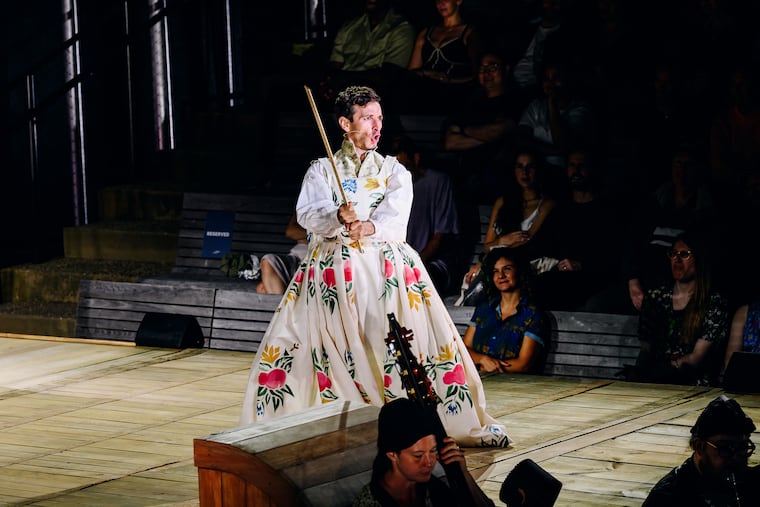New Opera Philadelphia chief does it all in ‘The Marriage of Figaro’
Not only does he sing all of the lead roles, but does it in five weekly performances at New York's Little Island Amphitheater. Is there any other opera star with the stage savvy to pull this off?

NEW YORK — Operatic enterprises don’t get any more quixotic than this. Opera Philadelphia’s new leader, Anthony Roth Costanzo, isn’t just performing Mozart’s complicated comedy The Marriage of Figaro, singing all of the lead roles but doing so in five weekly performances through Sept. 22 at the outdoor Little Island Amphitheater.
A green space off the coast of Manhattan’s West 13th Street, the man-made Little Island (opened in 2021) is foreign territory for many operagoers. But to judge from the roaring approval at Thursday’s opening (and the prevalent “sold out” notices on Little Island Tickets), this is one of those beyond-cool New York events that may require swimming in from the Hudson River to be a stowaway spectator.
Though The Marriage of Figaro often sprawls over four hours, this is a 100-minute intermissionless version which has countertenor Costanzo in such constant vocal and physical motion, that he is literally hauled offstage on a stretcher following the second of four acts.
After this, Costanzo might be relieved to be parked at his Opera Philadelphia office (where he is general director and president) planning opera rather than performing it.
Costanzo is able to sing the male and female roles in this upstairs-downstairs plot (servants ward off sexual advances of a predatory master) because his three-and-a-half-octave voice has a serviceable baritone register as well as his stronger, well-known soprano and mezzo-soprano countertenor notes that can (and have) filled the 3,800-seat Metropolitan Opera.
More remarkably, he can switch from countertenor to baritone in a nanosecond, which allowed him to sing multiple male and female roles in dialogue with each other.
And more: Complex ensembles had him singing with himself in a live sound loop, via a looping pedal that he stepped on to record the next line.
How could that work onstage? Without Costanzo holography? Imagine the wildest-possible knock-about commedia dell’arte-style production, multiply it by three ― and then some.
Director Dustin Wills, whose background includes working with puppet theater in Italy, had costumes and masks that are true (somewhat) to the opera’s 18th-century origins. Dresses, suits, hats, and props flew on and off Costanzo at warp speed in early scenes. Live actors later appeared onstage lip-synching Costanzo’s skillfully amplified voice that seemed to come from everywhere and nowhere. Amid farcical stage activity, you didn’t always know what voice belonged to which onstage actor.
But, is there any other opera star with the stage savvy to pull this off? Costanzo, notably, has history as a child star on Broadway.
This limitlessly clever production winked and jabbed at the opera but also poked fun at its own breezy lack of realism: While lip-synching one of the opera’s more soulful arias, one actress gave her mouth a rest, taking a cup of water from a nearby trap door, while the Costanzo voice warbled on.
Sure, there was mugging (character based, never cheap) and some elements existed purely for visual comedy, such as a trampoline that emerged from a large trap door on which the drunken gardener bounced around. And in the spirit of Costanzo’s too-much-information public persona, he is examined by a doctor whose stethoscope doubles as a camera, showing his inner vocal apparatus on nearby video screens. It’s eerie and breathtaking (no pun intended).
Yes, the opera was cut and massaged in many different ways to fit the solo performer and the abbreviated running time. Costanzo was given much-needed vocal rest when the actors performed passages (with their own voices) from the 1778 Pierre Beaumarchais play on which the opera is based, underscoring the class distinctions that led to the French Revolution. The production became a law unto itself that never felt truncated — a law that said you never knew what would happen next.
The comic momentum loses a bit of steam in the Mozart original; plot devices revolving around lost ribbons and nocturnal disguises start running thin. But here is where Costanzo, the vocal artist, stepped in. New York has a long tradition of gender-fluid interpretations of the classics. Like the legendary actor/playwright Charles Ludlam (1943-1987) and his Ridiculous Theatrical Company, Costanzo knows when to cut the comedy and go to the soul of the piece.
The sublime Act IV aria “Deh, vieni, non tardar” was the single richest, most refined, and insightful singing that I’ve heard from Costanzo. The Young People’s Chorus of New York City joined him in some of the opera’s final moments, reinforcing the genuine emotional content of this great opera.
However hectic the stage traffic, conductor Dan Schlosberg and the cut-down but mighty eight-member orchestra maintained Mozart’s innate sense of order. When the laughter stopped, Mozart still showed how the right people ended up with each other, and that this particular world is as it should be.
Tickets are $25, but remaining performances are sold out. Little Island Tickets says more tickets may get added.